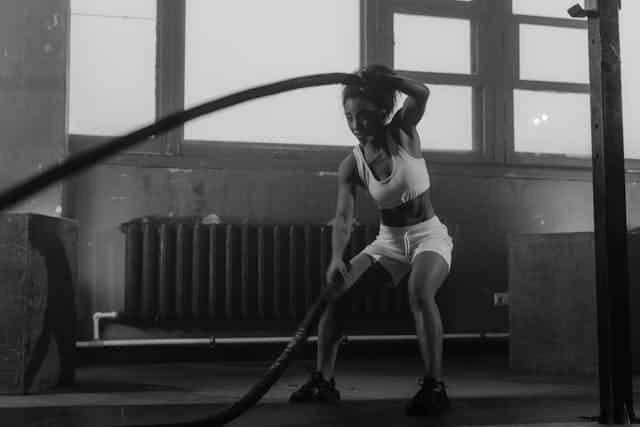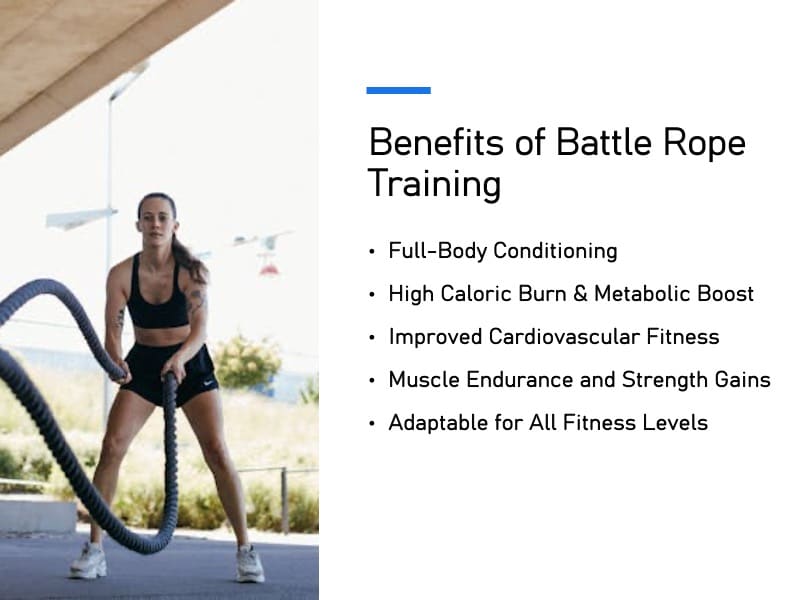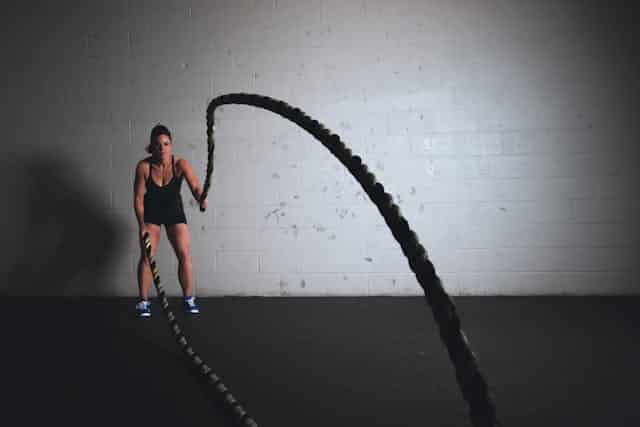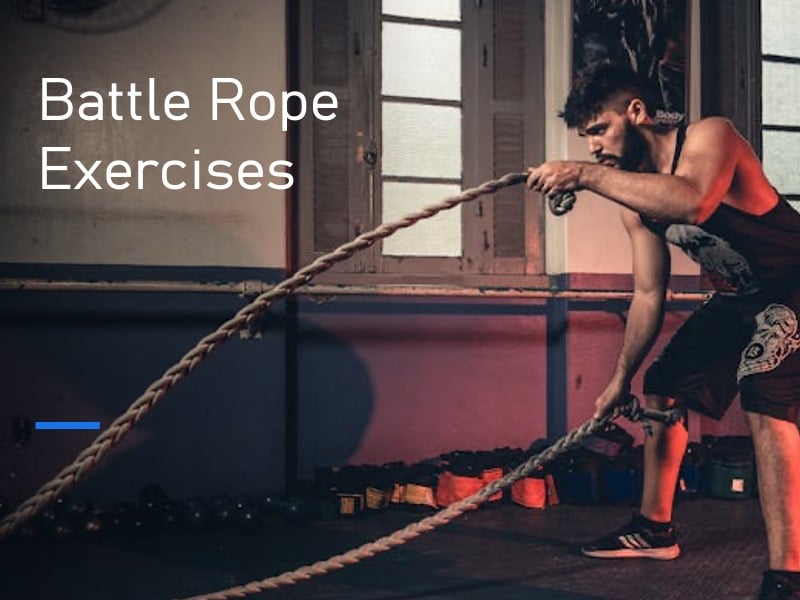Battle Ropes: Benefits, Exercises, How to Do, Muscles Worked
Battle ropes are one of the most underrated tools for building power, endurance, and total-body conditioning.
Unlike traditional strength or cardio workouts, they uniquely combine anaerobic and aerobic training to develop explosive force and metabolic stamina.
Battle ropes have been a staple in my training routine for over 15 years.
As a professional athlete, I’ve consistently used battle rope exercises and workouts to burn calories, develop metabolic conditioning, and improve body composition, without placing excessive stress on my joints.
They remain one of my favorite tools for conditioning because they deliver huge results through simple, low-impact movements that can be adapted for nearly any fitness level.
What makes battle rope training so effective is its ability to activate multiple muscle groups simultaneously while keeping the heart rate elevated.
This combination of full-body engagement and cardiovascular demand makes them an ideal option for anyone looking to optimize their workout efficiency.
Whether you’re training for performance or simply trying to improve your fitness, battle ropes provide a time-tested method for building strength, boosting endurance, and burning fat.
What Are Battle Ropes?

Battle ropes are thick, heavy-duty training ropes used primarily for high-intensity, full-body conditioning.
They are typically made from durable materials like poly dacron or polypropylene to withstand repeated impact and friction.
Standard battle ropes range from 30 to 50 feet in length and are usually 1.5 to 2 inches in diameter, with thicker ropes requiring greater grip strength and muscular effort.
Each rope is anchored at its midpoint, allowing the user to hold one end in each hand while creating wave-like or slamming motions.
The anchored setup turns the rope into a form of dynamic resistance, where the challenge comes not from the weight alone, but from the constant effort required to move and control the rope’s momentum.
Due to their design, battle ropes effectively combine elements of strength training, cardiovascular conditioning, and neuromuscular coordination.
They’re commonly found in athletic training facilities, CrossFit boxes, and increasingly in home gyms due to their versatility, low-impact nature, and ability to produce high-calorie burns in a short time.
What is Battle Rope Training?
Battle rope training involves gripping the ends of a heavy battle rope anchored at its midpoint and performing dynamic, wave-like movements to challenge the entire body.
Movements can include slams, waves, circles, and whips, performed with either one or both arms, for timed intervals or rep-based sets.
Although they originated in sports performance settings, battle ropes have become popular in both gyms and home workouts because they blend strength and cardio training into a single, versatile tool.
Unlike traditional weights, battle ropes offer constant resistance without momentum, keeping your muscles under tension throughout each movement.
This type of training targets the upper body, core, and lower body (when integrated with exercises such as squats, lunges, or movement patterns), and can improve cardiovascular endurance, muscular endurance, grip strength, and even mental toughness.
Because it’s scalable and doesn’t require heavy lifting, it’s also a joint-friendly method for high-intensity training.
Benefits of Battle Rope Training

Battle rope training is far more than a flashy gym trend; it’s a scientifically backed method for developing total-body strength, cardiovascular endurance, and explosive power.
Whether you’re an elite athlete or just beginning your fitness journey, battle ropes offer a time-efficient and low-impact way to challenge your body.
Backed by research and over a decade of practical use in my own training, the benefits of battle ropes extend well beyond aesthetics, supporting performance, fat loss, injury prevention, and functional movement.
Full-Body Conditioning
Battle rope exercises simultaneously engage the upper body, core, and lower body.
Movements like alternating waves or slams require coordination and power from your shoulders, arms, abs, hips, and even your legs for balance and stability.
This full-body activation makes battle rope exercises especially effective for improving functional strength and athletic performance.
High Caloric Burn & Metabolic Boost
Research confirms that battle ropes elicit significant metabolic demands, which is why it is great for both metabolic conditioning and body composition improvements.
A 10-minute protocol using 15-second intervals elevated heart rate to an average of 163 bpm and reached a peak VO₂ of 35.4 mL· kg¹ · min¹, which is equivalent to over 10 METs, indicating vigorous cardiovascular intensity (Fountaine & Schmidt, 2015).
Energy expenditure averaged 41.3 kJ· min¹, making it one of the most calorie-burning workouts in a short timeframe.
Improved Cardiovascular Fitness
Studies show that even short HIIT-style programs with battle ropes, such as 10 × 30-second intervals three times a week, can improve upper-body VO₂max and endurance, with improvements evident as early as three weeks (Bornath & Kenno, 2022).
This means battle rope training is a time-efficient alternative to traditional cardio workouts for those seeking to improve heart and lung health.
Muscle Endurance and Strength Gains
Battle ropes develop shoulder, back, and core strength.
Over the course of six weeks, participants using progressively heavier ropes experienced increases in shoulder power, voluntary contraction strength, and muscular endurance, comparable to those achieved through treadmill or cycling high-intensity interval training (HIIT) (Bornath & Kenno, 2022).
Because the ropes create continuous resistance, they also help improve muscular endurance by training your muscles to sustain force over longer periods.
Adaptable for All Fitness Levels
Whether performed seated, standing, or in motion, battle rope workouts can be scaled to match any ability level.
Seated or stance-based protocols still deliver 68–72% of an individual’s VO₂ max, offering a powerful cardiovascular challenge without requiring lower-body movement (Brewer et al., 2018).
This makes them an excellent tool for rehabilitation, injury recovery, or individuals with limited mobility who still want a strong cardio and strength stimulus.
Muscles Worked in Battle Rope Exercises

Battle rope training is often mistaken for just an upper-body workout, but in reality, it activates multiple major muscle groups throughout the entire body.
Battle ropes don’t isolate one muscle group; they integrate the entire kinetic chain.
Whether you’re performing waves, slams, or rotational throws, battle ropes require a constant blend of strength, stability, and coordination.
This total-body engagement builds real-world strength and conditioning that translates to both athletic performance and daily movement efficiency.
Upper Body
- Shoulders (Deltoids): Nearly every rope movement—especially waves and slams—requires sustained shoulder activation to maintain velocity and control.
- Arms (Biceps & Triceps): As you grip and move the rope, your biceps flex with each wave while your triceps stabilize and extend the arm during powerful slams or throws.
- Forearms & Grip Muscles: The dynamic nature of rope training creates high demand on grip strength and forearm endurance, especially with thicker ropes or longer intervals.
Core
- Rectus Abdominis & Obliques: Movements like side-to-side waves, snake waves, and grappler throws force the core to stabilize and rotate, activating both the front and sides of the abdominal wall.
- Transverse Abdominis & Deep Core Stabilizers: The need to resist excessive spinal movement during fast rope exercises recruits deep stabilizers, which improves posture and balance.
- Erector Spinae: These muscles support the lower back and are heavily engaged during full-body slams and upright stances.
Lower Body
- Glutes (Gluteus Maximus, Medius): Movements that incorporate squats, lunges, or jumps—such as burpee slams or alternating waves with a squat—recruit the glutes for power and stability.
- Quads & Hamstrings: Static stances and lower-body dynamic movements like jumping slams or lunge-to-wave variations place significant load on the upper legs.
- Calves (Gastrocnemius & Soleus): Active foot positioning and stability, especially in explosive movements, require consistent calf activation for balance and force transfer.
How to Use Battle Ropes Correctly
Battle ropes may look simple, but using them correctly is essential to maximize results and prevent injury.
Proper form and setup ensure that each movement targets the intended muscle groups while minimizing strain on the joints.
Whether you’re performing explosive slams or high-speed waves, mastering the basics of rope positioning, body alignment, and movement control will help you maximize the benefits of every session.
Set-Up Tips
- Anchor the rope to a stable, non-movable point.
- Ensure enough space around you to create waves without obstruction.
- Use gloves if you’re new to reduce hand fatigue and prevent rope burn.
Proper Form Basics
- Stand with feet shoulder-width apart and knees slightly bent.
- Brace your core and keep your spine neutral.
- Hold a rope end in each hand and generate movement primarily from the shoulders and arms, not by leaning or flailing.
The Best Battle Rope Exercises

After using battle ropes for over 15 years, I’ve found them to be one of the most versatile and effective tools for building strength, endurance, and explosive power.
These battle rope exercises are among my personal favorites, not just because they’re challenging, but because they deliver consistent results when programmed intentionally.
While there are dozens of variations, the exercises below offer a comprehensive starting point for improving conditioning, building functional muscle, and developing athletic movement patterns.
Double-Arm Waves
Raise and lower both arms simultaneously to create even, rhythmic waves that travel down the rope.
This basic battle rope exercise builds shoulder and arm endurance, quickly elevates heart rate, and reinforces full-body control through a stable core and balanced stance.
Alternating Waves
Move each arm independently, one at a time, to create alternating waves.
This movement introduces more neurological demand and core activation as your body stabilizes against the asymmetrical forces of each rope wave.
Slams
Lift both ends of the rope overhead and slam them into the ground as powerfully as possible.
Slams train explosive hip extension, improve posterior chain engagement, and help develop peak power output in the upper and lower body.
Side-to-Side Waves
Swing both arms together in a lateral motion from hip to hip, creating horizontal waves that flow across the floor.
This battle rope exercise targets the obliques and spinal stabilizers while developing rotational strength and frontal-plane movement control.
Snake Waves
Move both arms inward and outward at the same time, generating side-by-side waves that resemble two snakes slithering across the floor.
Snake waves challenge shoulder mobility and scapular control, while also requiring precision and rhythm to keep the waves smooth and continuous.
External Rotations
Hold the ropes at your sides with elbows bent and rotate your hands outward, creating small controlled waves.
This is an excellent movement for warming up the rotator cuff and promoting shoulder health, especially before upper-body training days.
Grappler Throws
Use a circular, figure-eight motion with your arms to simulate a throwing or swinging pattern.
Grappler throws enhance transverse-plane strength, core rotation, and shoulder mobility, making them a valuable addition to any athletic conditioning routine.
Jumping Slams or Burpee Slams
Combine rope slams with plyometric exercises, such as jumps or burpees, to increase intensity and elevate your heart rate.
This advanced variation builds explosive lower-body power and upper-body force production while enhancing coordination and metabolic conditioning.
Best Battle Rope Workouts
Battle rope workouts are highly customizable and can be tailored to nearly any training goal, whether you’re focused on fat loss, endurance, power, or metabolic conditioning.
Unlike traditional weightlifting, battle rope training often relies on timed intervals, wave cadence, and movement variation to create intensity and drive adaptation.
By adjusting variables such as work-to-rest ratio, duration, rope thickness, and exercise type, you can create a workout that suits your fitness level and helps you make progress.
Tabata Intervals for Battle Ropes
One of my favorite, most effective, and intense ways to use battle ropes is through Tabata workouts.
A traditional Tabata interval protocol consists of 20 seconds of maximal effort followed by 10 seconds of rest, repeated for 8 total rounds (4 minutes).
For battle ropes, a sample Tabata set might include:
- Exercise: Alternating Waves or Double-Arm Slams
- Protocol: 8 rounds of 20 seconds on, 10 seconds off
- Goal: Maintain consistent wave speed and amplitude throughout all intervals
This format has been shown to rapidly elevate heart rate, increase oxygen consumption, and create a significant metabolic afterburn.
Battle rope Tabatas are particularly effective for fat loss and anaerobic conditioning, and they require no equipment changes or transitions between movements, making them perfect for both time efficiency and intensity.
You can perform multiple rounds of Tabata using different exercises (e.g., slams, waves, side-to-side motions) or pair battle ropes with bodyweight exercises like squats or push-ups for a full-body HIIT session.
Beginner Protocol
- 10 rounds of:
15 seconds alternating waves
45 seconds rest
This format has been shown to elevate heart rate and improve VO₂max in as little as 10 minutes (Fountaine & Schmidt, 2015).
Intermediate/Advanced Protocol
- 10 x 30-second bouts alternating exercises (double-arm/alternating/slams)
- Rest 30–60 seconds between rounds
- Increase weight of the rope, if possible, after 3–4 weeks for continued adaptation (Bornath & Kenno, 2022)
Tips for Maximizing Results with Battle Ropes
- Rest Intervals Matter: Shorter rests between rounds increase energy expenditure and cardiovascular demand (Ratamess et al., 2015).
- Use a Metronome: Helps keep a consistent wave cadence for standardization and progressive overload.
- Track Progress: Monitor wave speed, rope weight, and session duration to see tangible improvements.
Final Thoughts: Should You Do Battle Rope Exercises?
If you’re looking for a high-impact training tool that delivers results without requiring hours in the gym, battle ropes are an exceptional choice.
They combine strength, endurance, and coordination into a single modality, offering one of the most efficient ways to condition your entire body, especially when time, space, or equipment is limited.
What makes battle ropes truly excellent is their ability to drive adaptations across multiple energy systems while minimizing joint strain.
In just 10 to 15 minutes, you can spike your heart rate, build upper-body and core endurance, and tap into anaerobic pathways that traditional cardio often misses.
After more than a decade of using battle ropes personally and professionally, I can say they’re not just effective, they’re sustainable.
Their versatility makes them suitable for both beginners and elite athletes, whether you’re training for a sport, aiming to lose fat, or simply looking to improve your daily mobility.
If you want to challenge your body, improve your conditioning, and avoid the monotony of traditional workouts, battle ropes are absolutely worth including in your routine.
Frequently Asked Questions About Battle Ropes
This website does not provide medical advice. This website site does contain affiliate links, and purchases may earn a commission.
Read my Medical Disclaimer, Review Disclaimer, and Publishing Policies for more details. Use of this site indicates acceptance of these terms.



